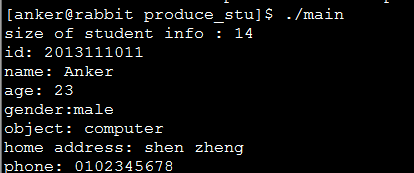protobuf-c的学习总结
1、前言
项目中用到protobuf-c进行数据序列化,好处在于后期程序扩展性非常好,只需要改动proto的定义就可以保持兼容,非常的灵活方便。关于protobuf-c的详细介绍可以参考google官方文档。https://code.google.com/p/protobuf-c/。在此简单的介绍一下基本功能。proto文件格式如下所示:
message AMessage
{
requried int32 a = ; //a必须出现
optional string b = ; //b是可选的
repeated int32 c = ; //c是数组
}
字段规则类型:
required:表示后面的数据是必须的。
optional:表示后面数据是可选的。
repeated:表示后面的数据是一个数组。
标量数值类型
|
.proto类型 |
Java 类型 |
C++类型 |
备注 |
|
double |
double |
double |
|
|
float |
float |
float |
|
|
int32 |
int |
int32 |
使用可变长编码方式。编码负数时不够高效——如果你的字段可能含有负数,那么请使用sint32。 |
|
int64 |
long |
int64 |
使用可变长编码方式。编码负数时不够高效——如果你的字段可能含有负数,那么请使用sint64。 |
|
uint32 |
int[1] |
uint32 |
Uses variable-length encoding. |
|
uint64 |
long[1] | uint64 | Uses variable-length encoding. |
|
sint32 |
int |
int32 |
使用可变长编码方式。有符号的整型值。编码时比通常的int32高效。 |
|
sint64 |
long |
int64 |
使用可变长编码方式。有符号的整型值。编码时比通常的int64高效。 |
|
fixed32 |
int[1] |
uint32 |
总是4个字节。如果数值总是比总是比228大的话,这个类型会比uint32高效。 |
|
fixed64 |
long[1] |
uint64 |
总是8个字节。如果数值总是比总是比256大的话,这个类型会比uint64高效。 |
|
sfixed32 |
int |
int32 |
总是4个字节。 |
|
sfixed64 |
long |
int64 |
总是8个字节。 |
|
bool |
boolean |
bool |
|
|
string |
String |
string |
一个字符串必须是UTF-8编码或者7-bit ASCII编码的文本。 |
|
bytes |
ByteString |
string |
可能包含任意顺序的字节数据。 |
2、测试程序
编写一个学生信息的proto,proto文件内容如下所示:
message Student
{
required string id = ;
required string name = ;
required string gender = ;
required int32 age = ;
required string object = ;
required string home_address = ;
required string phone = ;
}
编译命令: protoc-c --c_cout=. student.proto
生成student.pb-c.c 和 student.pb-c.h两个文件。student.pb-c.h文件内容如下所示:
/* Generated by the protocol buffer compiler. DO NOT EDIT! */ #ifndef PROTOBUF_C_student_2eproto__INCLUDED
#define PROTOBUF_C_student_2eproto__INCLUDED #include <google/protobuf-c/protobuf-c.h> PROTOBUF_C_BEGIN_DECLS typedef struct _Student Student; /* --- enums --- */ /* --- messages --- */ struct _Student
{
ProtobufCMessage base;
char *id;
char *name;
char *gender;
int32_t age;
char *object;
char *home_address;
char *phone;
};
#define STUDENT__INIT \
{ PROTOBUF_C_MESSAGE_INIT (&student__descriptor) \
, NULL, NULL, NULL, , NULL, NULL, NULL } /* Student methods */
void student__init
(Student *message);
size_t student__get_packed_size
(const Student *message);
size_t student__pack
(const Student *message,
uint8_t *out);
size_t student__pack_to_buffer
(const Student *message,
ProtobufCBuffer *buffer);
Student *
student__unpack
(ProtobufCAllocator *allocator,
size_t len,
const uint8_t *data);
void student__free_unpacked
(Student *message,
ProtobufCAllocator *allocator);
/* --- per-message closures --- */ typedef void (*Student_Closure)
(const Student *message,
void *closure_data); /* --- services --- */ /* --- descriptors --- */ extern const ProtobufCMessageDescriptor student__descriptor; PROTOBUF_C_END_DECLS #endif /* PROTOBUF_student_2eproto__INCLUDED */
测试proto程序如下所示:
#include <stdio.h>
#include <errno.h>
#include <stdlib.h>
#include <string.h>
#include "student.pb-c.h" #define ID_LEN 11
#define NAME_LEN 32
#define GENDER_LEN 10
#define OBJECT_LEN 20
#define HOME_ADDR_LEN 96
#define PHONE_LEN 12 static int malloc_student_info(Student *stu)
{
stu->id = (char*)malloc(ID_LEN);
if (!stu->id)
{
goto FAILED;
}
stu->name = (char*)malloc(NAME_LEN);
if (!stu->name)
{
goto FAILED;
}
stu->gender = (char*)malloc(GENDER_LEN);
if (!stu->gender)
{
goto FAILED;
}
stu->object = (char*)malloc(OBJECT_LEN);
if (!stu->object)
{
goto FAILED;
}
stu->home_address = (char*)malloc(HOME_ADDR_LEN);
if (!stu->home_address)
{
goto FAILED;
}
stu->phone = (char*)malloc(PHONE_LEN);
if (!stu->phone)
{
goto FAILED;
}
return ;
FAILED:
fprintf(stdout, "malloc error.errno:%u,reason:%s\n",
errno, strerror(errno));
return -;
} static void free_student_info(Student *stu)
{
if (stu->id)
{
free(stu->id);
stu->id = NULL;
}
if (stu->name)
{
free(stu->name);
stu->name = NULL;
}
if (stu->gender)
{
free(stu->gender);
stu->gender = NULL;
}
if (stu->object)
{
free(stu->object);
stu->object = NULL;
}
if (stu->home_address)
{
free(stu->home_address);
stu->home_address = NULL;
}
if (stu->phone)
{
free(stu->phone);
stu->phone = NULL;
}
} static void set_student_info(Student *stu)
{
const char *id = "";
const char *name = "Anker";
const char *gender = "male";
const char *object = "computer";
const char *address = "shen zheng";
const char *phone = ""; strncpy(stu->id, id, ID_LEN);
strncpy(stu->name, name, NAME_LEN);
strncpy(stu->gender, gender, GENDER_LEN);
stu->age = ;
strncpy(stu->object, object, OBJECT_LEN);
strncpy(stu->home_address, address, HOME_ADDR_LEN);
strncpy(stu->phone, phone, PHONE_LEN);
} void print_student_info(Student *stu)
{
printf("id: %s\n",stu->id);
printf("name: %s\n",stu->name);
printf("age: %d\n",stu->age);
printf("gender:%s\n",stu->gender);
printf("object: %s\n",stu->object);
printf("home address: %s\n",stu->home_address);
printf("phone: %s\n",stu->phone);
} int main()
{
Student stu = STUDENT__INIT;
void *buf = NULL;
unsigned int len ;
Student *msg = NULL; if (malloc_student_info(&stu) == -) {
exit();
}
set_student_info(&stu); //get student packed size
len = student__get_packed_size(&stu);
printf("size of student info : %u\n",len);
buf = malloc(len);
//put student info pack to buf
student__pack(&stu, buf); //unpack student info from buf
msg = student__unpack(NULL, len, buf);
print_student_info(msg);
//free msg
student__free_unpacked(msg, NULL); free(buf);
free_student_info(&stu); return ;
}
编译命令: gcc student.pb-c.c main.c -o main -lprotobuf-c
测试结果如下所示:

3、参考网址
http://www.cnblogs.com/dkblog/archive/2012/03/27/2419010.html
https://code.google.com/p/protobuf-c/wiki/Examples
protobuf-c的学习总结的更多相关文章
- protobuf中会严重影响时间和空间损耗的地方
http://blog.chinaunix.net/uid-26922071-id-3723751.html 当前项目中普遍用到GOOGLE 的一个开源大作PROTOBUF,把它作为网络应用层面的传输 ...
- Protobuf在Python中的应用(序列化数据)
1.了解Protobuf Protocol Buffer是Google的语言中立的,平台中立的,可扩展机制的,用于序列化结构化数据 - 对比XML,但更小,更快,更简单.您可以定义数据的结构化,然后可 ...
- 移动端IM开发者必读(二):史上最全移动弱网络优化方法总结
1.前言 本文接上篇<移动端IM开发者必读(一):通俗易懂,理解移动网络的“弱”和“慢”>,关于移动网络的主要特性,在上篇中已进行过详细地阐述,本文将针对上篇中提到的特性,结合我们的实践经 ...
- go语言学习--protobuf的学习
最近在学习中遇到了protobuf,哇喔竟然不知道,马上进行了学习,protobuf也是数据解析的方式,平时使用最多的是json和xml,那么好了,对比下他们的区别,并且附上protobuf的使用. ...
- 学习 protobuf(一)—— ubuntu 下 protobuf 2.6.1 的安装
下载地址:https://github.com/google/protobuf/releases/download/v2.6.1/protobuf-2.6.1.tar.gz(如果初次下载失败,不妨多试 ...
- Netty学习(七)-Netty编解码技术以及ProtoBuf和Thrift的介绍
在前几节我们学习过处理粘包和拆包的问题,用到了Netty提供的几个解码器对不同情况的问题进行处理.功能很是强大.我们有没有去想这么强大的功能是如何实现的呢?背后又用到了什么技术?这一节我们就来处理这个 ...
- Netty学习——Netty和Protobuf的整合(二)
Netty学习——Netty和Protobuf的整合(二) 这程序是有瑕疵的,解码器那里不通用,耦合性太强,有两个很明显的问题,但是要怎么解决呢?如:再加一个内部类型 Person2,之前的代码就不能 ...
- Netty学习——Netty和Protobuf的整合(一)
Netty学习——Netty和Protobuf的整合 Protobuf作为序列化的工具,将序列化后的数据,通过Netty来进行在网络上的传输 1.将proto文件里的java包的位置修改一下,然后再执 ...
- Netty学习——Google Protobuf使用方式分析和环境搭建
Google Protobuf使用方式分析 在RPC框架中,Google Protobuf是很常用的一个库,和Apache Thrift 是同款的用于进行序列化的第三方库.原理都是大同小异,无非就是使 ...
- google protobuf学习笔记:windows下环境配置
欢迎转载,转载请注明原文地址:http://blog.csdn.net/majianfei1023/article/details/45371743 protobuf的使用和原理,请查看:http:/ ...
随机推荐
- myeclipse优化 Maven
1.禁用myeclipse updating indexes MyEclipse 总是不停的在 Update index,研究发现Update index...是Maven在下载更新,但很是影响mye ...
- STM32 TIMER OUTPUT DIAGRAM
- Calculate CAN bit timing parameters
Calculate CAN bit timing parameters TSYNC_SEG === 1 TSEG1 = Prop_Seg + Phase_Seg1 TSEG2 = Phase_Seg2 ...
- ISO 7816-4: Annex A: Transportation of APDU messages by T=0
http://www.cardwerk.com/smartcards/smartcard_standard_ISO7816-4_annex-a.aspx Annex A: Transportation ...
- Linux/CentOS服务器 一个网卡绑定多IP地址(永久设置)
有时我们在使用 Linux 服务器时需要配置多个IP地址.如果要配置多个IP地址是否需要多块网卡呢?答案是否定的.以 CentOS 系统为例,多个 IP 地址是可以共享一块物理网卡的. 如何永久为单网 ...
- libxml2.dylb 罗致<libxml/tree.h> 老是找不到头文件
libxml2.dylb 导致<libxml/tree.h> 老是找不到头文件 添加了libxml2.dylb的framework ,结果还是引用不了<libxml/tree.h&g ...
- uifont 字体详解
时间2013-06-04 11:26:33 CSDN博客原文 http://blog.csdn.net/u010013695/article/details/9020611 我们在开发中很多时候要设 ...
- iPhone系统常用文件夹位置
1. [/Applications] 常用软件的安装目录 2. [/private /var/ mobile/Media /iphone video Recorder] iphone v ...
- 【多线程】java多线程实现生产者消费者模式
思考问题: 1.为什么用wait()+notify()实现生产者消费者模式? wait()方法可以暂停线程,并释放对象锁 notify()方法可以唤醒需要该对象锁的其他线程,并在执行完后续步骤,到了s ...
- ifeq endif
ifeq ($(PLATFORM_VERSION),4.4)$(info "________________________4.4"); LOCAL_CFLAGS += -DPLU ...
